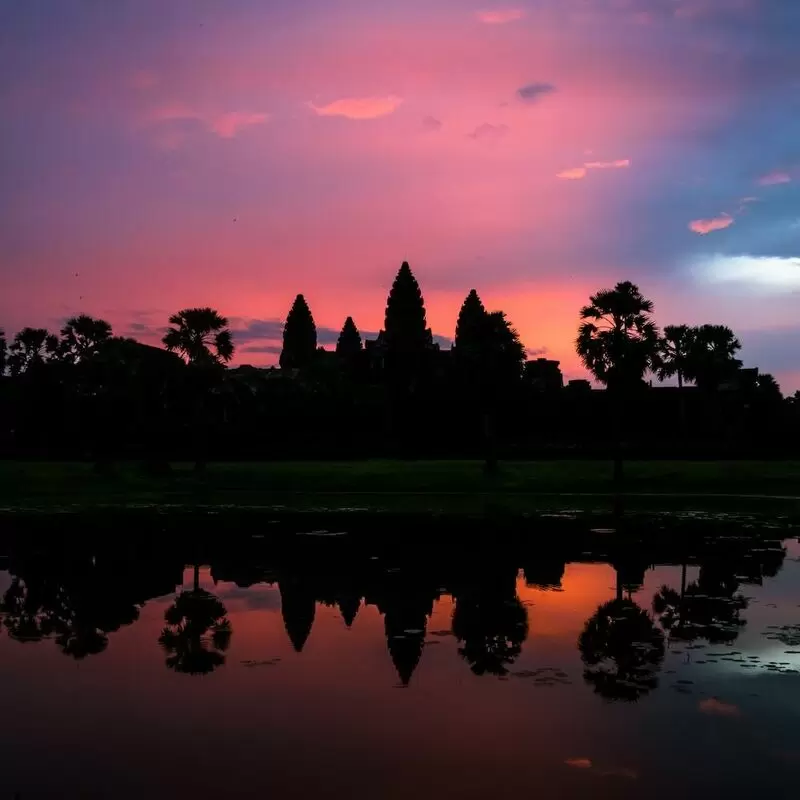
1. Angkor Wat
Awaken your senses like Indiana Jones at Angkor Wat, a remnant of Khmer architectural genius. This UNESCO World Heritage site has an intoxicating appeal. The silhouette of the central complex at dawn makes for a unique photo opportunity. Unmissable are the Apsara dancers carved into the sandstone. To satisfy your explorer instincts, take a short detour to the less crowded but equally fascinating Ta Prohm Temple, where tree roots triumph over ancient stone. Remember that loud shouting disturbs the temple spirits!
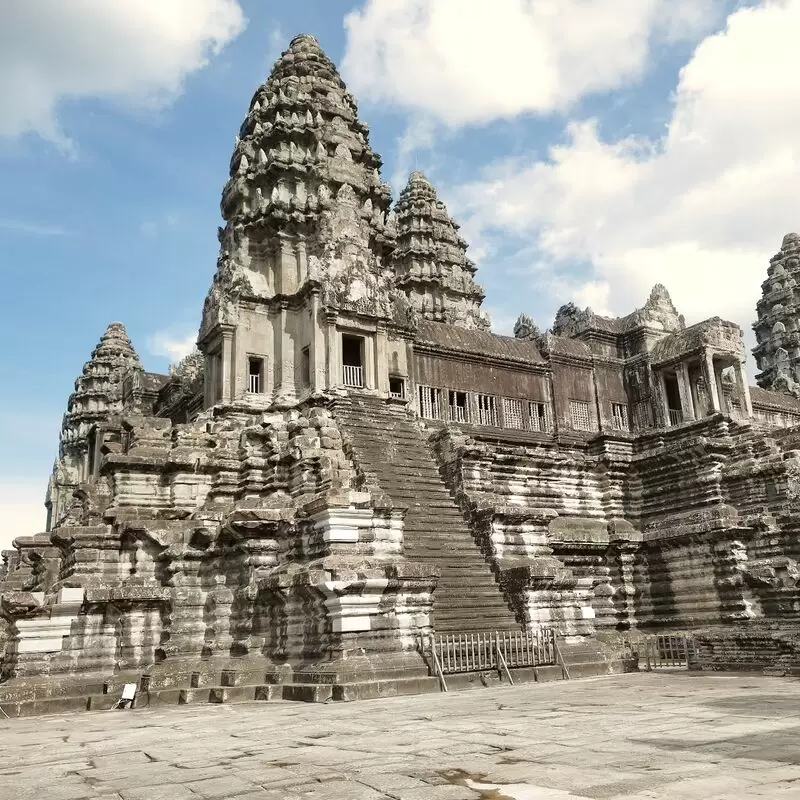 Angkor Wat
Angkor Wat
Krong Siem Reap

Krong Siem Reap
2. Ta Prohm Temple
Ta Prohm Temple stands out from other Angkor temples with its haunting beauty. Embraced by Mother Nature, it is interwoven with strangler figs and silk trees. Ta Prohm offers an enchanting labyrinth of stone passageways, courtyards and surreal root systems. It also gained superstar status from its role in the movie Tomb Raider. Just a short tuk-tuk ride away, you'll find the majestic Angkor Wat. Find a secluded spot and soak up the mystique of Ta Prohm.
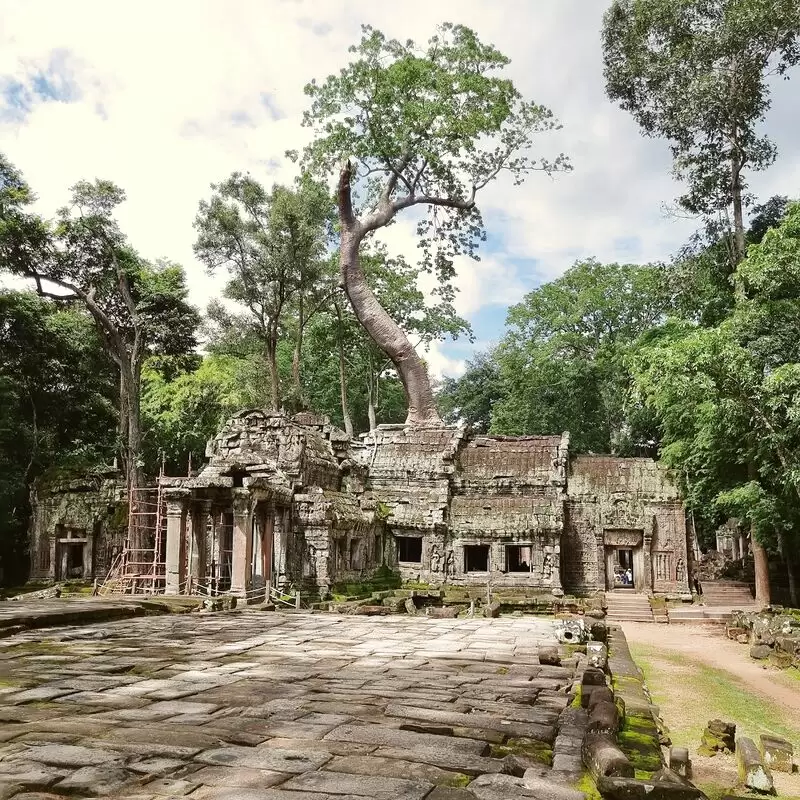 Ta Prohm Temple
Ta Prohm Temple
Krong Siem Reap
Monday - Sunday: 7:30 AM – 5:30 PM

Krong Siem Reap
3. Bayon Temple
The hauntingly beautiful Bayon Temple in Siem Reap is a true marvel with more than 200 enigmatic smiling faces carved in stone. Explore the mysterious passageways and see the temple come to life at dusk. Get lost in the captivating engravings depicting daily life and significant battles. Pro-tip: Be there early to catch the sunrise. Also, don't miss the nearby Elephant Terrace, which features remarkable bas-reliefs of these revered animals.
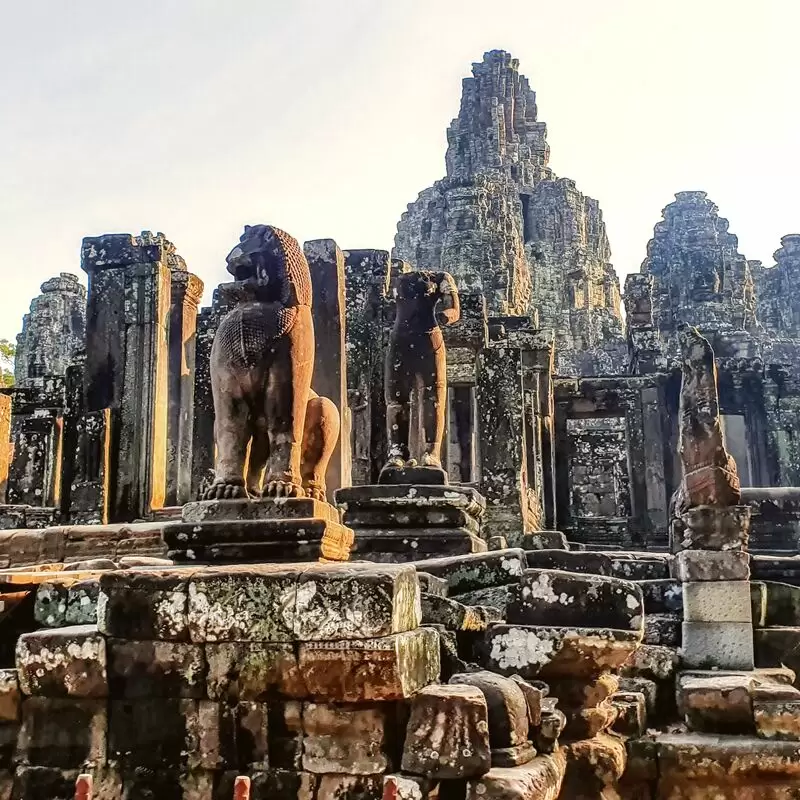 Bayon Temple
Bayon Temple
Krong Siem Reap
Monday - Sunday: 7:30 AM – 5:30 PM

Krong Siem Reap
4. Preah Khan Temple
Embark on a journey through history at the Preah Khan Temple in Siem Reap! Explore the ancient pathways where royal processions once traveled, admire the intricate carvings carved in stone, and let the tranquil atmosphere bring you to a sense of peaceful contemplation. You'll be sure to appreciate the faint traces of old paint on some of the walls - a rare sight! Just a stone's throw away, you can continue your adventure at the equally fascinating Neak Pean, an artificial island temple.
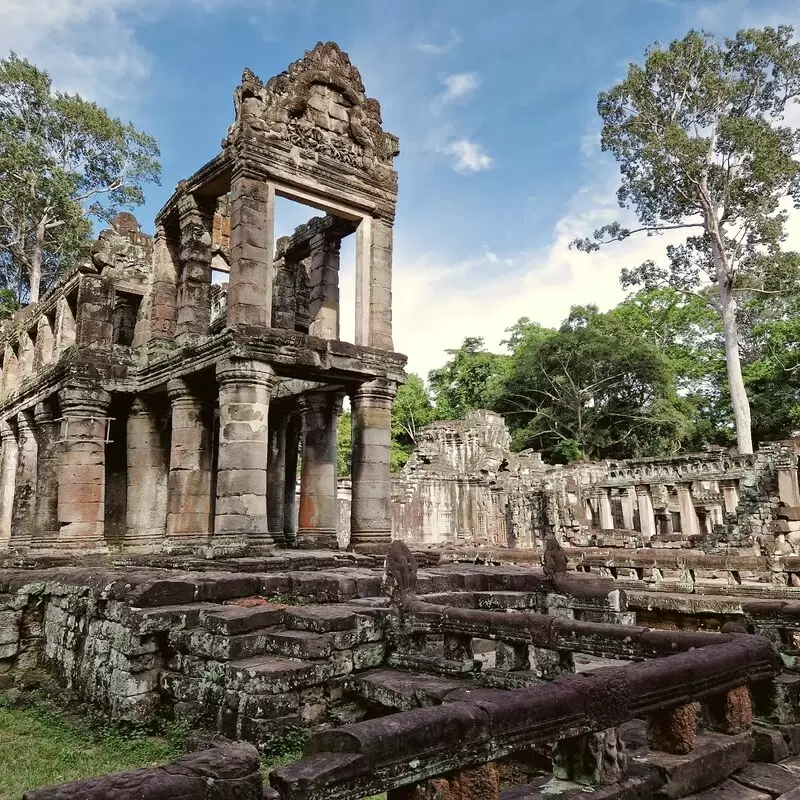 Preah Khan Temple
Preah Khan Temple
FV6C+QJ4, Krong Siem Reap
Monday - Saturday: 7:30 AM – 5:00 PM
Sunday: Closed

FV6C+QJ4, Krong Siem Reap
Sunday: Closed
5. Phnom Bakheng
Known for its enchanting sunset views, Phnom Bakheng is an important part of the magical Angkor complex. Located on a hill, the temple offers panoramic views of the Angkor landscape, including the impressive Angkor Wat. To avoid the crowds, arrive early or opt for an elephant ride to the top, which is a unique experience. Don't miss the nearby hidden gem of Phnom Krom, a smaller but beautiful hilltop temple known for its tranquility.
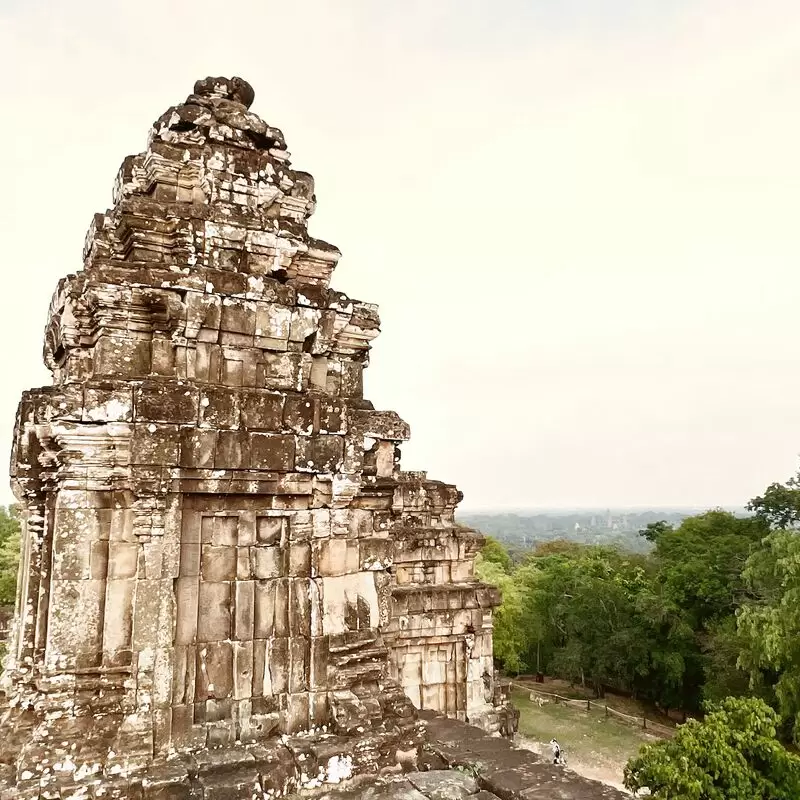 Phnom Bakheng
Phnom Bakheng
Angkor Archaeological Park, Krong Siem Reap
Monday - Sunday: 7:00 AM – 6:30 PM

Angkor Archaeological Park, Krong Siem Reap
6. Baphuon Temple
Discover the ancient secrets of Baphuon Temple, where history whispers through crumbling stone corridors. Climb the three-story pyramid structure, unlike other Angkor temples, and be rewarded with panoramic views over Siem Reap. The 8-meter-high reclining Buddha hidden in the west facade adds to the mystery. Just a few steps away awaits the tranquil Elephant Terrace, another magnificent complex with detailed carvings of elephants. Experience the mystique and grandeur of this building, inextricably linked to Cambodia's golden age.
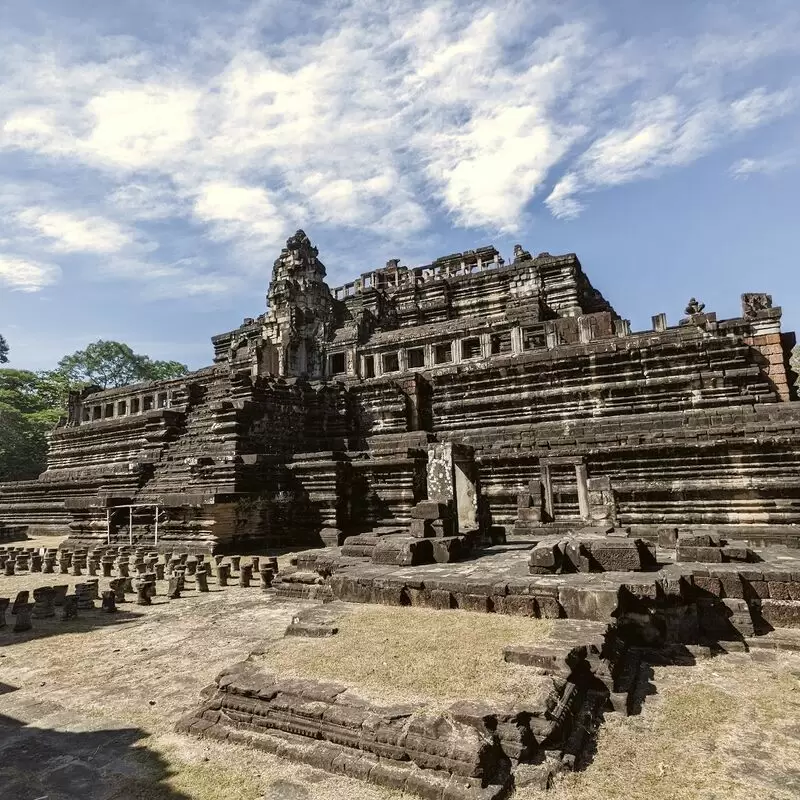 Baphuon Temple
Baphuon Temple
Angkor Archaelogical Park, Krong Siem Reap
Monday - Sunday: 7:30 AM – 5:00 PM

Angkor Archaelogical Park, Krong Siem Reap
7. Banteay Kdei
Set amidst stunning natural surroundings, Banteay Kdei is a fascinating labyrinth of 12th century Buddhist architecture. It is a unique, less crowded alternative to Angkor Wat, but has similar impressive bas-reliefs and intricate stone carvings. For an authentic experience, visit the "Hall of Dancers," adorned with charming apsara carvings. Nearby is the magnificent Ta Prohm, whose stone walls intertwine with jungle roots and offer a glimpse of nature's reclaiming power. Celebrate history and culture at Banteay Kdei, where past and present combine beautifully.
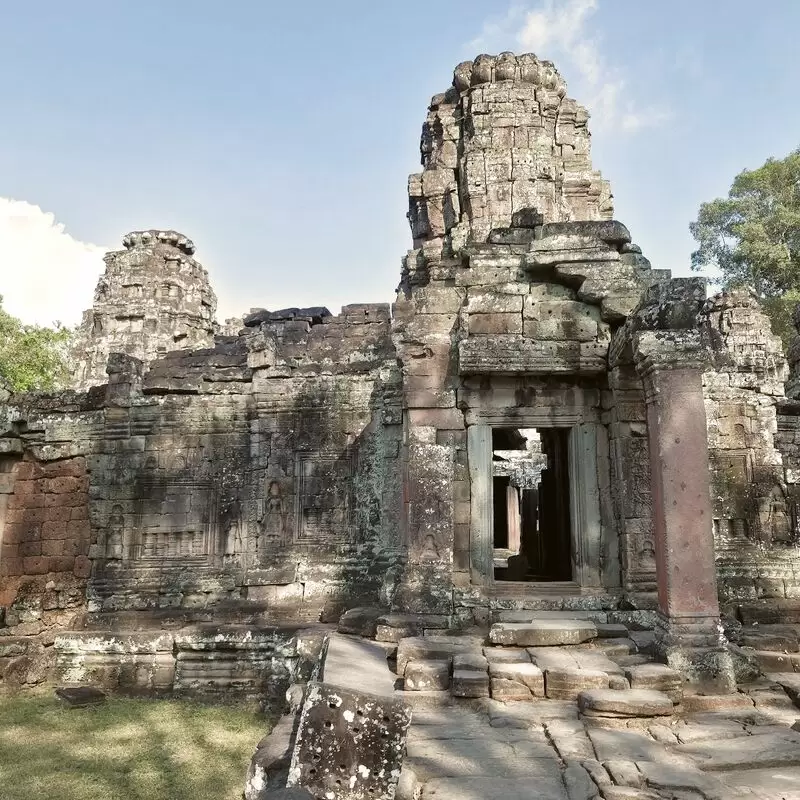 Banteay Kdei
Banteay Kdei
Angkor Archaeological Park, Krong Siem Reap
Monday - Sunday: 7:30 AM – 5:30 PM

Angkor Archaeological Park, Krong Siem Reap
8. Pre Rup temple
For an enchanting blend of history and scenery, visit Pre Rup Temple in Siem Reap. This architecturally magnificent 10th-century temple is best known for its dramatic sunset views, which cast a warm glow on the temple's stone structure. Feel like Indiana Jones as you explore the mysterious chambers and courtyards. Remember to arrive early to secure the best spot. Just a short drive away is the tranquil East Mebon Temple, another architectural marvel to tantalize your senses.
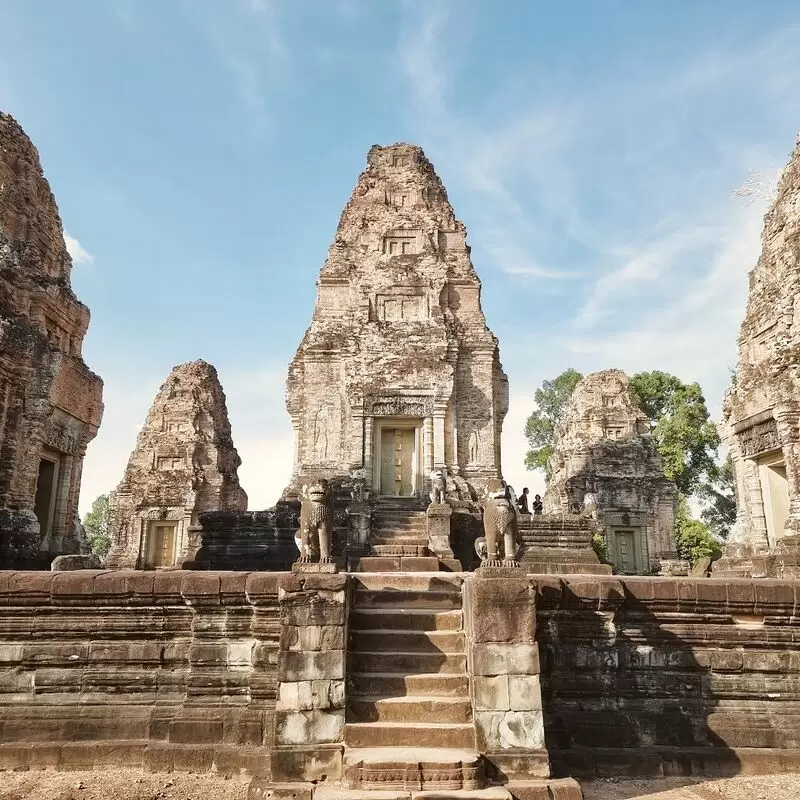 Pre Rup temple
Pre Rup temple
CWMC+X6F Angkor Archaeological Park, Krong Siem Reap
Monday - Sunday: 7:30 AM – 5:30 PM

CWMC+X6F Angkor Archaeological Park, Krong Siem Reap
9. Eastern Mebon
Immerse yourself in the rich history of the Khmer Empire at Eastern Mebon, known for its majestic elephant statues guarding every corner. The site was built in the 10th century and was originally located in the middle of a large baray (water reservoir). Today it sits on dry land and offers an experience like walking on a historic island. Don't miss the finely crafted lintels and devatas (female deities). Then explore Pre Rup, just a short drive away, another majestic temple that will impress you with its rustic orange hue at sunset.
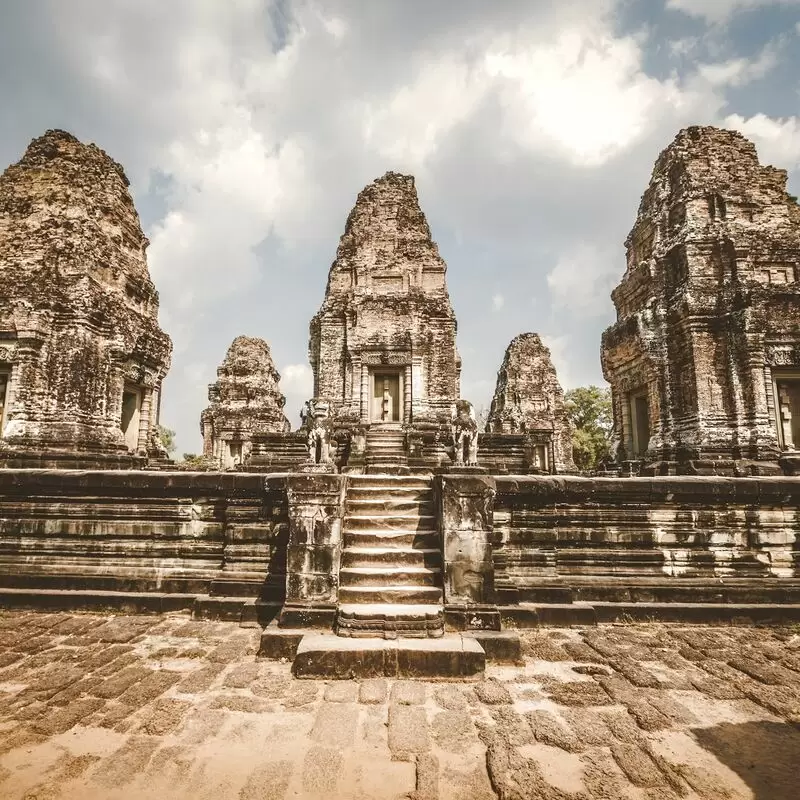 Eastern Mebon
Eastern Mebon
CWWC+J2H, Krong Siem Reap
Monday - Sunday: 7:30 AM – 5:30 PM

CWWC+J2H, Krong Siem Reap
10. Ta Som
Exploring Ta Som, a charming yet picturesque temple in Siem Reap, is a journey into the past. Surrounded by colossal trees that seem to protect the ancient stones, the temple offers an intimate encounter with Cambodia's rich history. This late 12th-century Hindu sanctuary has been spared large crowds, so you can fully enjoy the detailed carvings and tranquil atmosphere. Located a short walk from its famous neighbor East Mebon, Ta Som captivates with its tranquility amidst evocative reminders of a bygone era.
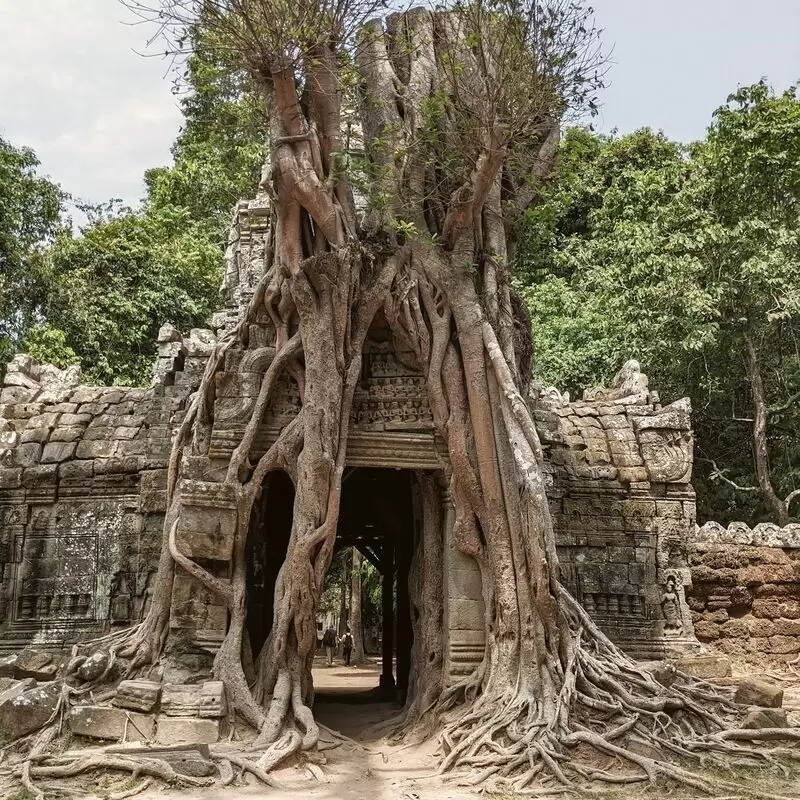 Ta Som
Ta Som
Angkor Archaeological Park, Krong Siem Reap

Angkor Archaeological Park, Krong Siem Reap
11. Phare The Cambodian Circus
Phare, the Cambodian Circus, offers an unforgettable experience in Siem Reap. Marvel at the acrobatics, drama, and artistry that are seamlessly woven together in each performance, offering a magical glimpse into Cambodian history and culture. The performers are graduates of a local school that provides unique artistic training to disadvantaged youth. Come early to see the amazing art gallery inside. Located just south of the night market, after the performance you can enjoy the local flair while shopping or dining in vibrant Siem Reap!
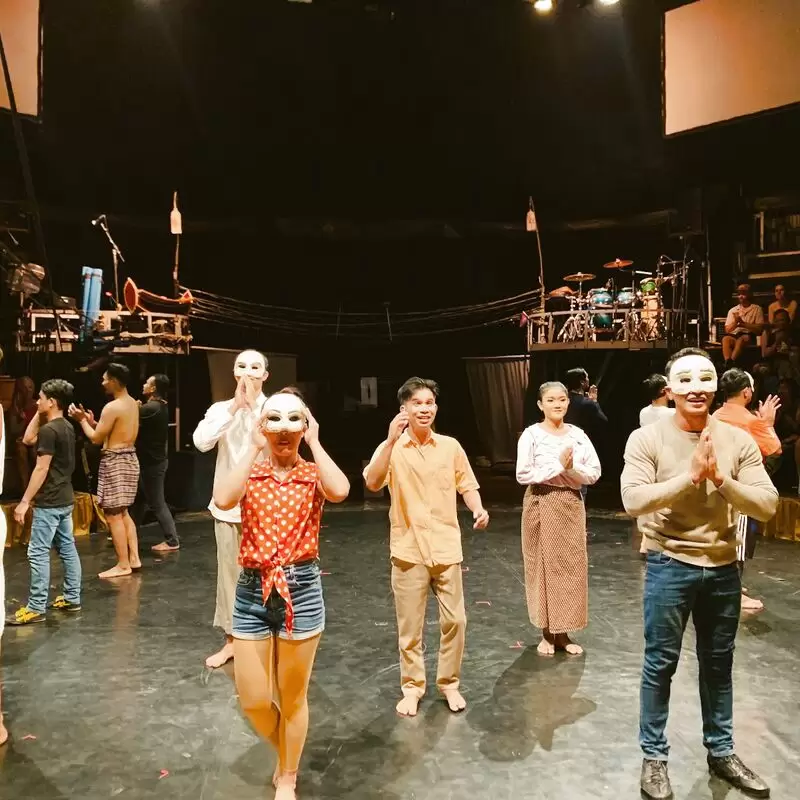 Phare The Cambodian Circus
Phare The Cambodian Circus
Ring Road, south of the, Intersection, Sok San Rd, Krong Siem Reap
Monday - Sunday: 8:00 AM – 9:00 PM

Ring Road, south of the, Intersection, Sok San Rd, Krong Siem Reap
12. Terrace of the Elephants
Embark on a journey through time at the "Terrace of Elephants" in Siem Reap. Here, you'll be mesmerized by the 350-meter-long ornate carvings of elephants, dancers, and mythical creatures on the 12th-century architectural masterpiece. While reminiscing about Angkor's golden era, don't forget to visit the nearby "Terrace of the Leper King" to delve even deeper into Cambodia's enchanting past. Legend has it that this terrace bears the name of a leprous ruler - another insider detail that adds to the mystery of ancient Cambodia.
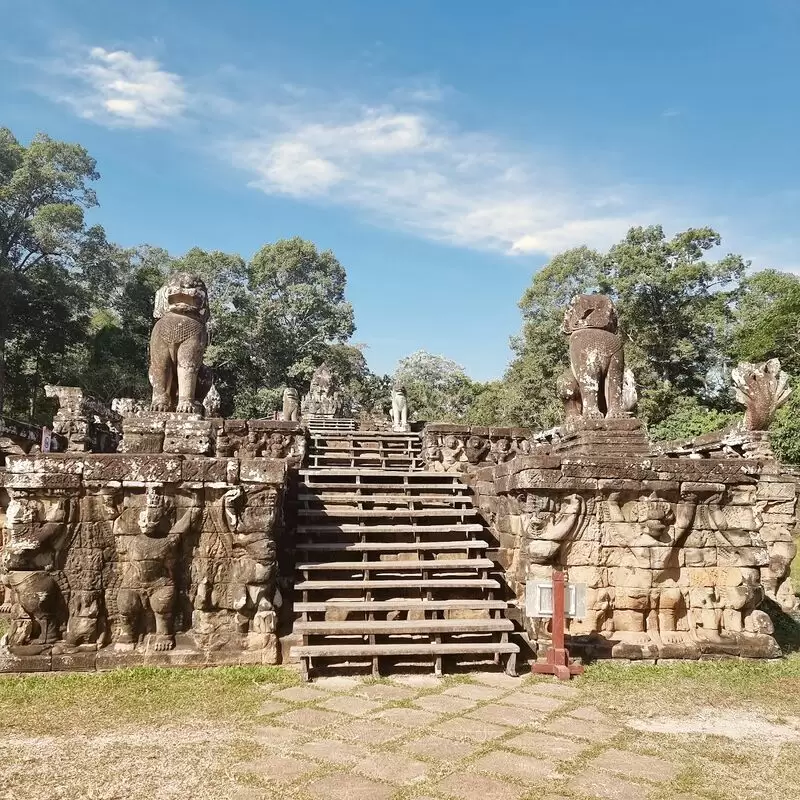 Terrace of the Elephants
Terrace of the Elephants
CVW5+9G3, Krong Siem Reap
Monday - Sunday: 7:00 AM – 5:30 PM

CVW5+9G3, Krong Siem Reap
13. Bakong Temples
The Bakong temples offer an incredible balance between tranquility and historical splendor. This underrated gem is the first major temple built during the Khmer Empire. Imagine losing yourself in this intricate labyrinth of sandstone sculptures, with mythical stories unfolding at every turn. Enjoy the reflective light of the sunset - a best kept secret for insiders! Just a short tuk-tuk ride away, you'll find the stunning Roluos Group of Monuments, another glimpse of the splendor of Khmer culture.
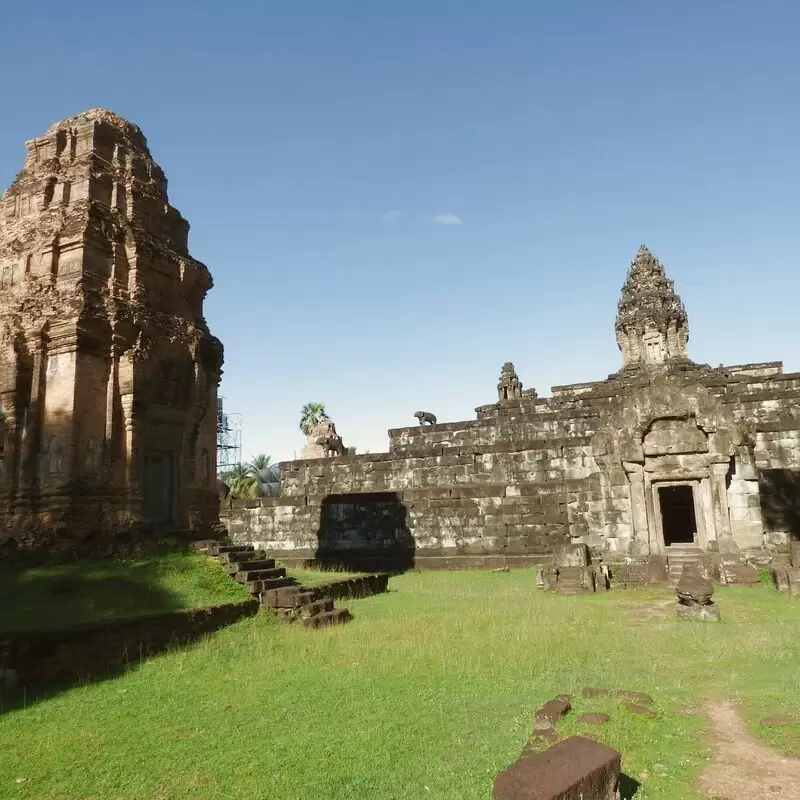 Bakong Temples
Bakong Temples
Prasat Bakong
Monday - Sunday: 7:30 AM – 5:30 PM

Prasat Bakong
14. Ta Keo
For those interested in architecture and history, a visit to Ta Keo in Siem Reap is a must! It is a large temple mountain dedicated to Shiva that fascinates as an unfinished testimony of history and makes you think about its unfinished stories. Its steep steps illustrate how difficult it is to reach the realm of the gods. Uniquely, Ta Keo has no carvings and remains a "monochrome" monument. Nearby, you can also visit the phenomenal temples of Angkor Thom and Bayon to extend your time travel!
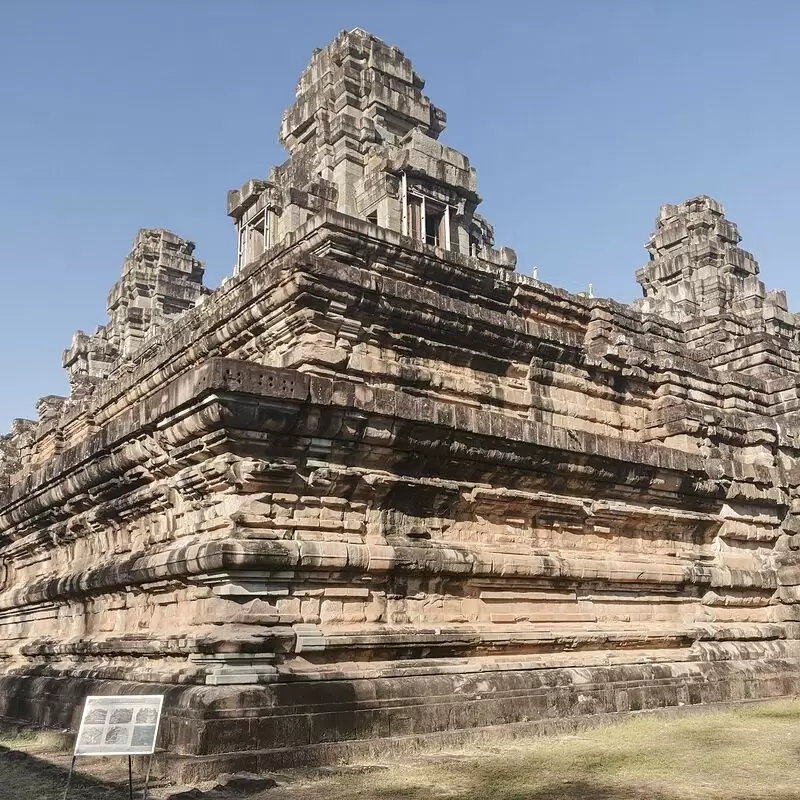 Ta Keo
Ta Keo
CVVJ+RWQ, Krong Siem Reap
Monday - Sunday: 7:00 AM – 5:30 PM

CVVJ+RWQ, Krong Siem Reap
15. Royal Independence Gardens
Take a quiet break at the Royal Independence Gardens, a lush oasis right in the bustling heart of Siem Reap. Enjoy the tranquility amid lotus-filled ponds, a statuesque 9-headed snake, and playful monkeys. Don't miss the Queen's Monument with its beautifully manicured flower beds and picturesque sight. After the immense complexity of Angkor, it is the first choice of locals to relax. Right next door, the famous Raffles Grand Hotel, a magnificent relic of French colonial architecture, is another must-see.
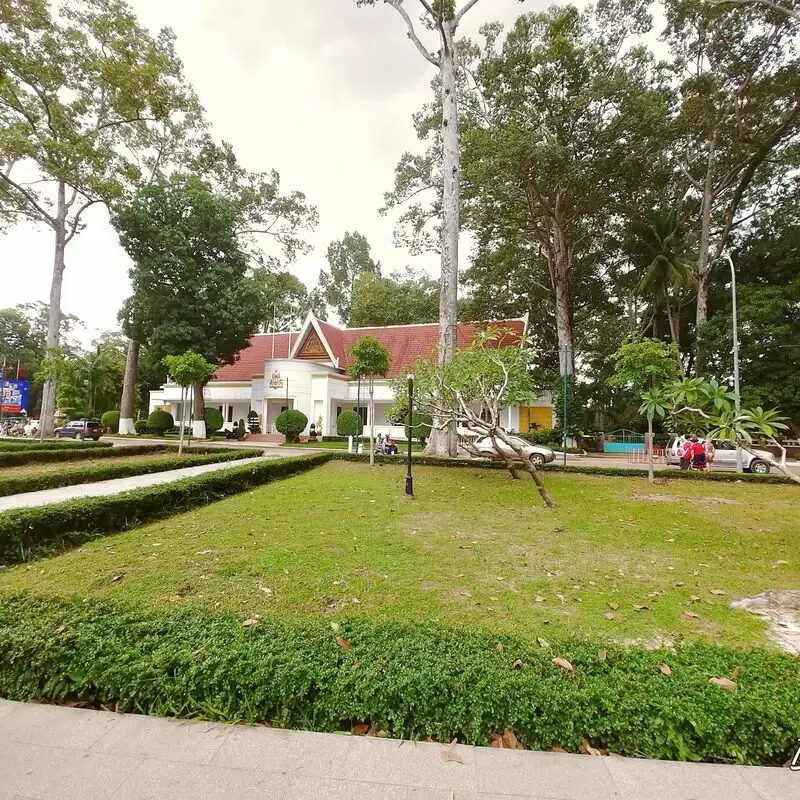 Royal Independence Gardens
Royal Independence Gardens
ផ្លូវជាតិលេខ 6, National Route 6 (Airport Road), Krong Siem Reap
Monday - Sunday: Open 24 hours

ផ្លូវជាតិលេខ 6, National Route 6 (Airport Road), Krong Siem Reap
16. Preah Ko
Immerse yourself in ancient Khmer culture and visit Preah Ko, one of the oldest temples in Siem Reap. Admire the intricate carvings and six majestic towers that pay homage to the ruler's ancestors. Be transported back in time as you explore the maze-like ruins. The other jewels of the Roluos Group, Bakong and Lolei, are just a stone's throw away and offer you a comprehensive impression of historical splendor. Don't miss an encounter with the resident bats - they add an exciting touch to your visit!
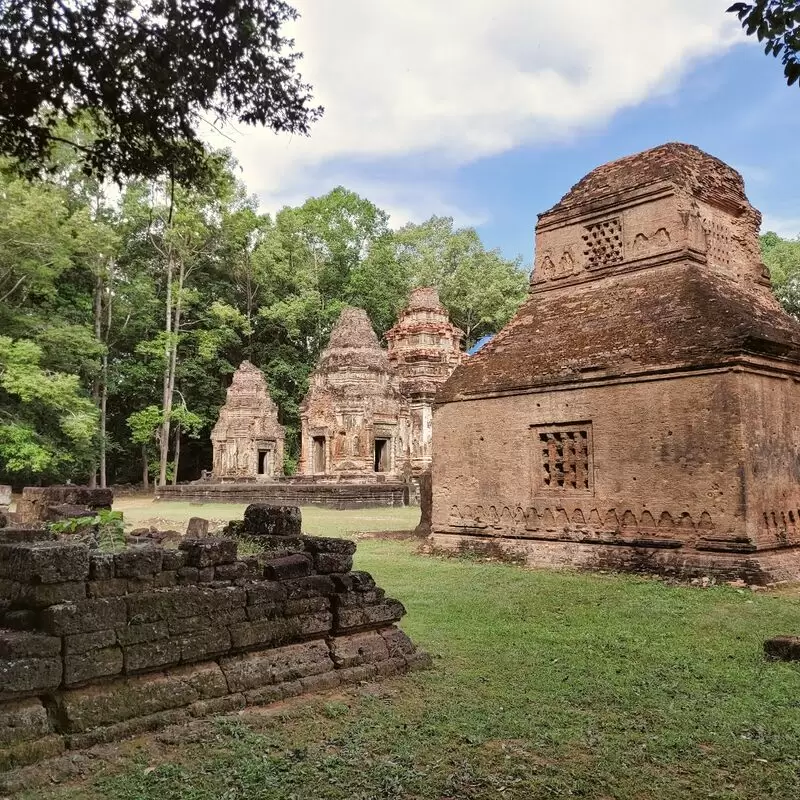 Preah Ko
Preah Ko
Angkor Archaeological Park, Krong Siem Reap
Monday - Sunday: 7:30 AM – 5:30 PM

Angkor Archaeological Park, Krong Siem Reap
17. Angkor National Museum
Embark on a captivating journey through time at the Angkor National Museum! This majestic museum houses 1,000 artifacts from the golden era of Angkor and showcases the rich history and culture of Siem Reap. From epic battle scenes engraved in sandstone to divine statues of granite gods, each exhibit tells a compelling story. Just a short walk away is the Royal Palace Garden, an ideal place for a refreshing stroll after visiting the museum. Don't miss the museum's Gallery of 1,000 Buddhas - a must-see!
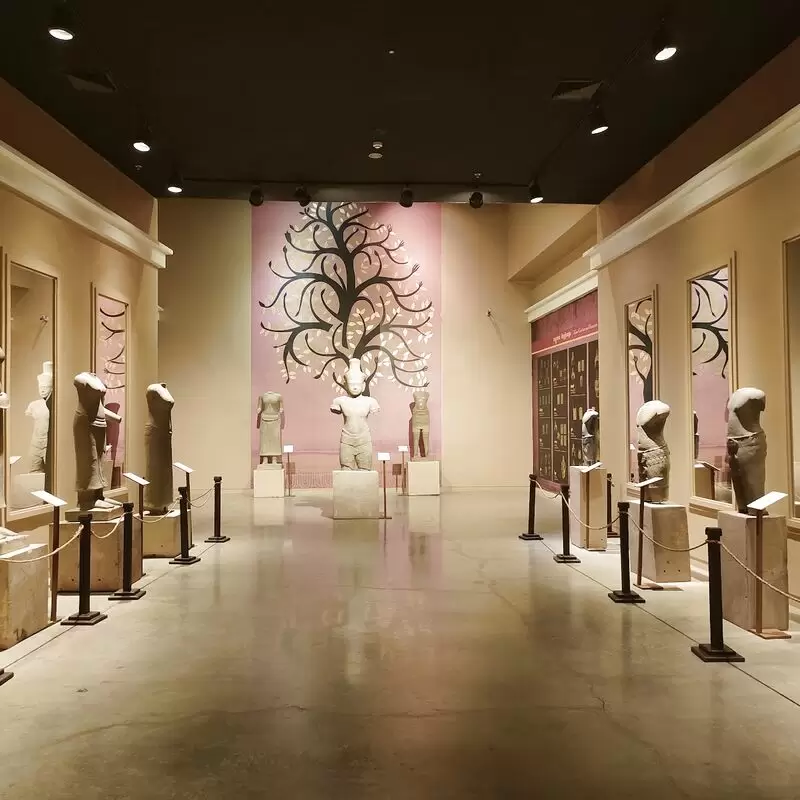 Angkor National Museum
Angkor National Museum
968 Vithei Charles De Gaulle, Krong Siem Reap
Monday - Sunday: 8:30 AM – 6:00 PM

968 Vithei Charles De Gaulle, Krong Siem Reap
18. Pub Street
Immerse yourself in the cultural diversity of Siem Reap at Pub Street! It is a vibrant hotspot full of life and an absolute must for those who love nightlife. With a variety of restaurants, bistros, pubs and food stalls, the street is full of energy. Try the famous fish amok or enjoy exotic Khmer barbecue dishes. And just a stone's throw away is the dazzling Angkor Night Market - perfect for a late-night shopping spree. Remember that after sunset, the street transforms into a vibrant neon spectacle.
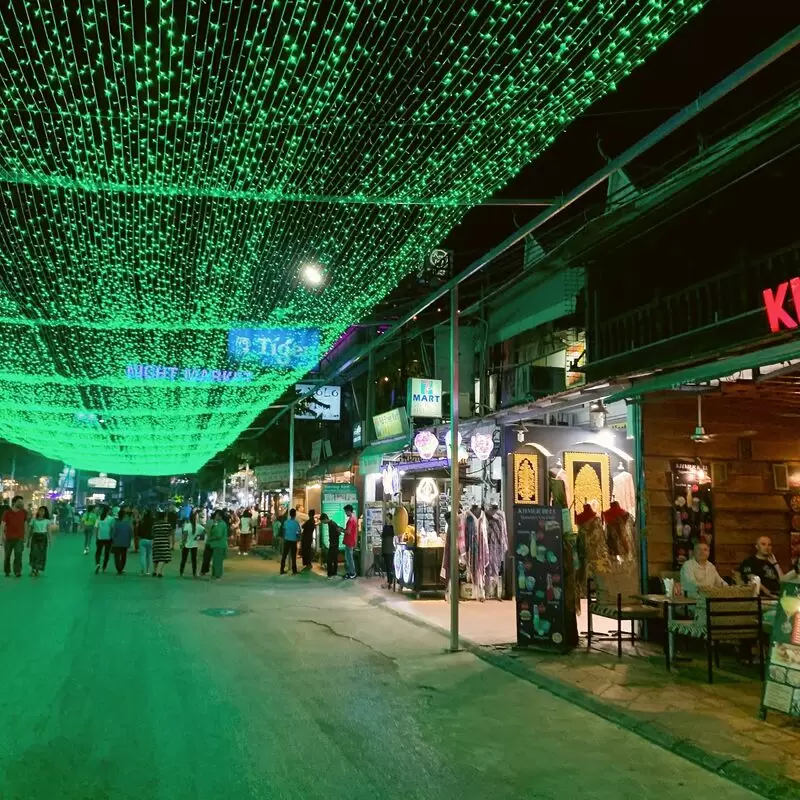 Pub Street
Pub Street
Street 08, Krong Siem Reap
Monday - Sunday: Open 24 hours

Street 08, Krong Siem Reap
19. Chau Say Tevoda Temple
Venture off the beaten path to Chau Say Tevoda Temple, a hidden gem of ancient Khmer architecture. Enjoy the tranquility away from the hustle and bustle of Angkor Wat. Immerse yourself in the romance of the mythological stories engraved on the sandstone walls of the temple. This temple is the quiet sibling of the famous Thommanon Temple, located across the street. It's a match made in heaven, combining two different interpretations of history within walking distance. A must-see for spiritual explorers and history buffs.
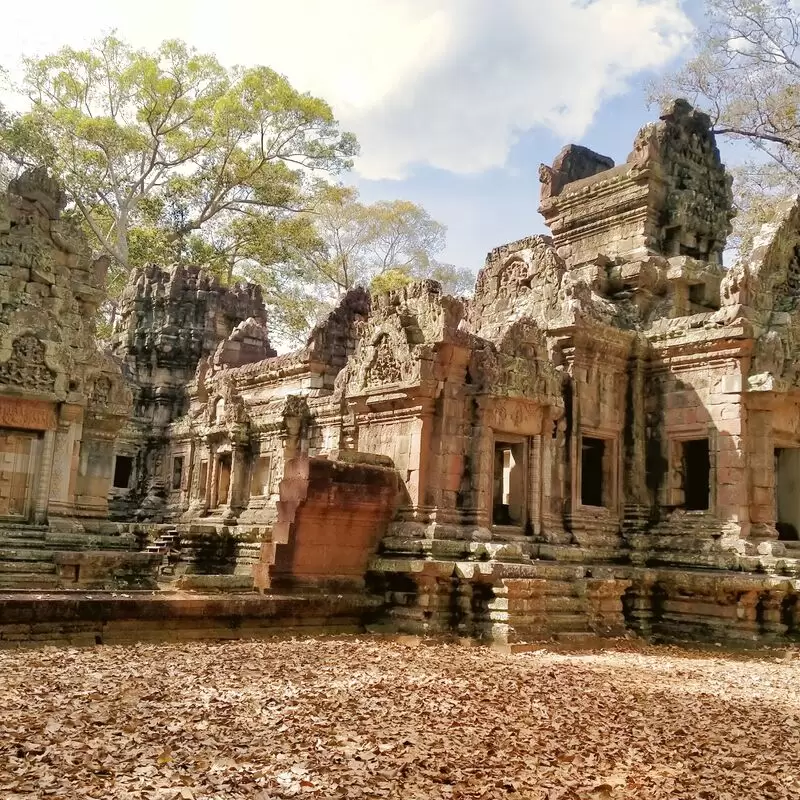 Chau Say Tevoda Temple
Chau Say Tevoda Temple
Angkor Archaeological park, Krong Siem Reap
Monday - Sunday: 7:30 AM – 5:30 PM

Angkor Archaeological park, Krong Siem Reap
20. Siem Reap Art Center Night Market
The Siem Reap Art Center Night Market is a fascinating hub where local artisans offer their beautiful creations. Get lost in the rows of colorful stalls offering an array of handmade jewelry, Khmer-style clothing, silk scarves, antique items, paintings and more. It's a treasure trove of unique, locally made memorabilia. Plus, you can try your hand at haggling! Across the river, you can explore the lively Pub Street with its many delicious food stalls, restaurants and lively bars.
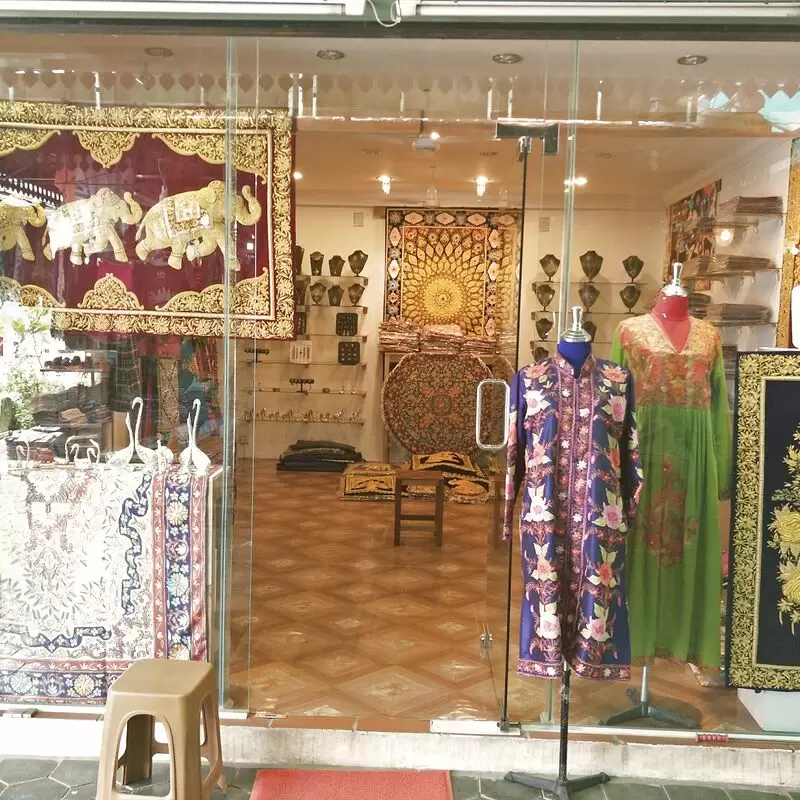 Siem Reap Art Center Night Market
Siem Reap Art Center Night Market
17000 Hospital St, Krong Siem Reap
Monday - Saturday: 4:00 – 11:00 PM
Sunday: Closed

17000 Hospital St, Krong Siem Reap
Sunday: Closed
21. Artisans Angkor
Artisans Angkor is an encouraging story of Cambodia's rich past told through expertly crafted arts and crafts. The Khmer heritage is preserved with the beautiful silk work, stone and wood carvings made by local artisans. Watch the live demonstrations and try some out for yourself! It is also an ideal place to buy unique souvenirs. Nearby, the fascinating temple complexes of "Angkor Wat" are waiting to be discovered by you, offering you a rich cultural experience.
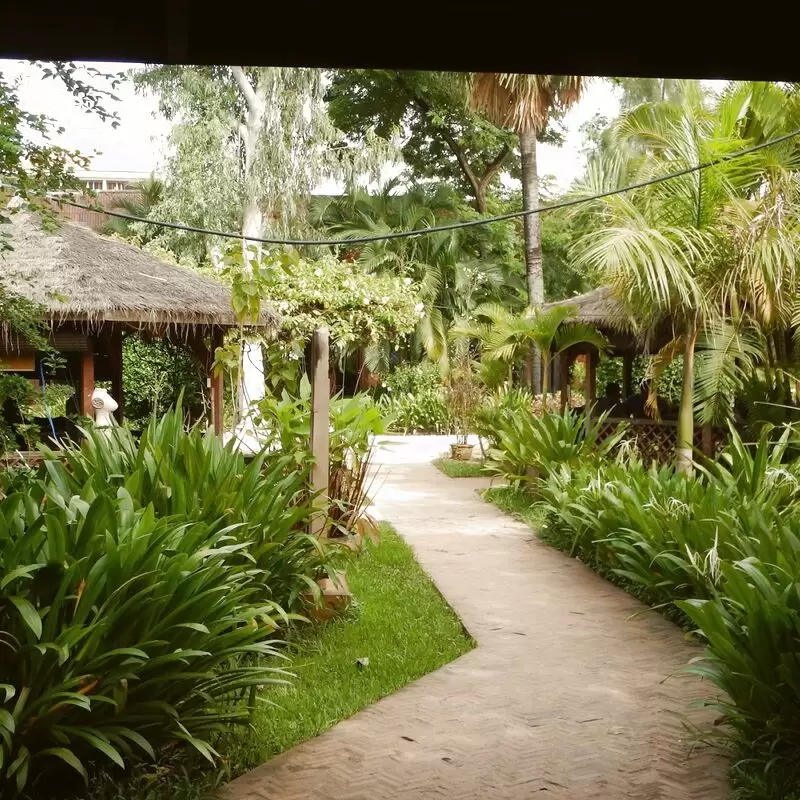 Artisans Angkor
Artisans Angkor
Chantiers-Ecoles Stung Thmey, Street, Krong Siem Reap
Monday - Sunday: 8:00 AM – 5:00 PM

Chantiers-Ecoles Stung Thmey, Street, Krong Siem Reap
22. Ta Nei Temple
Make your way to "Ta Nei Temple", a hidden gem amidst the lush greenery of Siem Reap. The temple is sparsely visited, giving it a mysterious and tranquil aura. The ancient reliefs and overturned stones carved from sandstone tell of Angkor's history. Along the way, enjoy an enchanting walk along the North Baray, a large water reservoir. Be an explorer off the beaten path and soak up the history in the quiet splendor of Ta Nei Temple - a journey well worth taking.
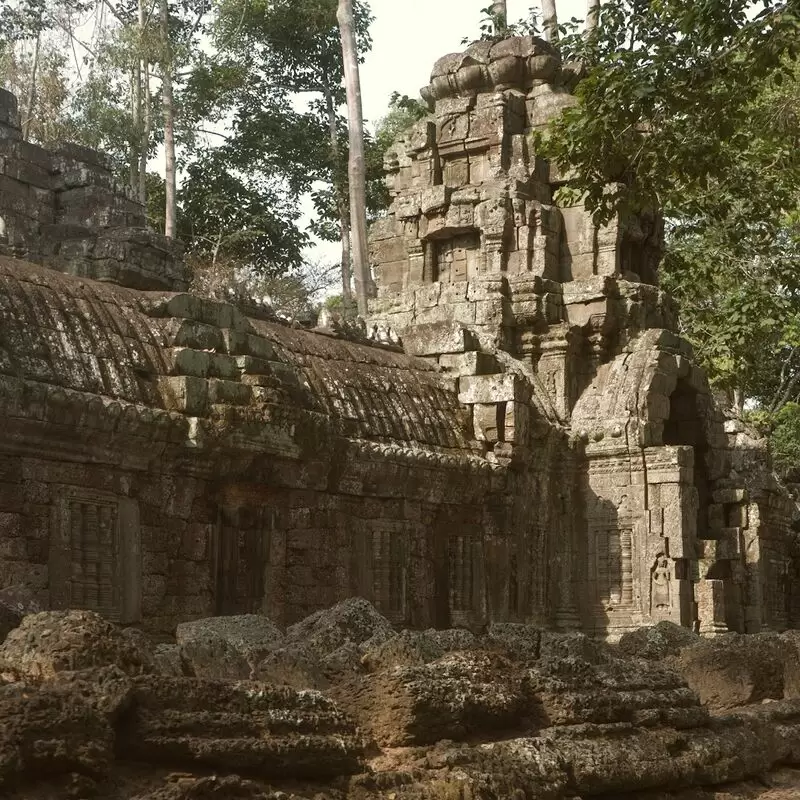 Ta Nei Temple
Ta Nei Temple
FV3P+255, Krong Siem Reap
Monday - Sunday: 7:00 AM – 5:30 PM

FV3P+255, Krong Siem Reap
23. War Museum Cambodia
If you are a history buff, you should visit the War Museum Cambodia in Siem Reap. It displays remnants of Cambodia's three-decade war, explained by guides who personally experienced the conflict. An unexpected highlight is the "Mine Garden," which displays various types of land mines. The fascinating relic is a fighter plane used during the Vietnam War. Nearby, you can admire the exotic flora at the Angkor Centre for Conservation of Biodiversity, which provides a peaceful contrast to your educational museum visit.
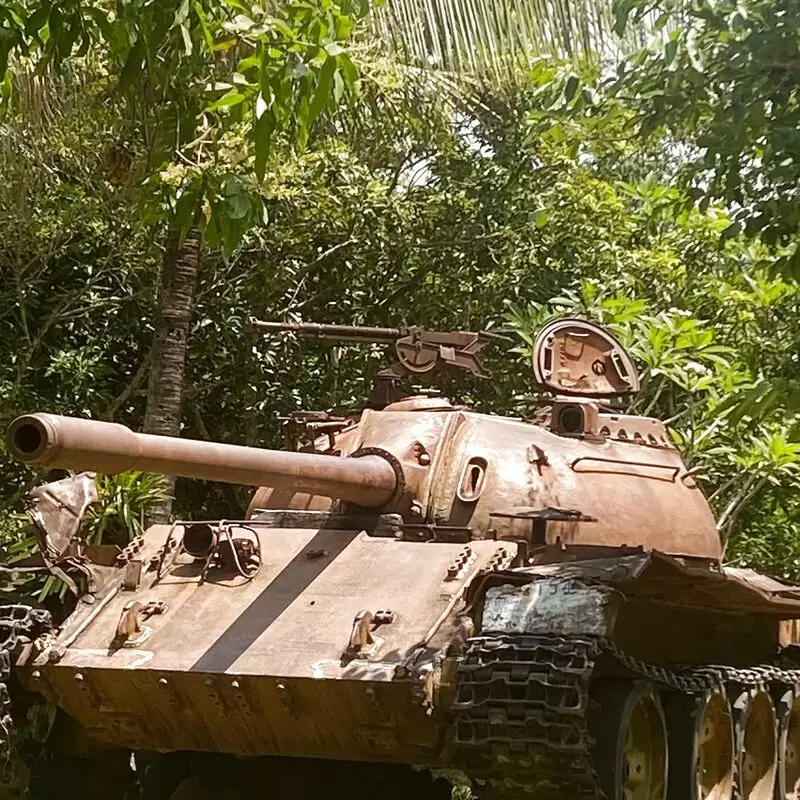 War Museum Cambodia
War Museum Cambodia
Sra Nge Commune, Krong Siem Reap
Monday - Sunday: 8:00 AM – 5:30 PM

Sra Nge Commune, Krong Siem Reap
24. Phsar Leu Thom Tmey
Phsar Leu Thom Tmey", Siem Reap's largest traditional market, offers an enticing immersion into local culture. Here, traditional lifestyle and lively trade intersect, resulting in a fascinating cross-cultural exchange. Stroll through the colorful hustle and bustle and be seduced by the captivating sights, aromatic smells and bustling sounds. This is a haven for unique antiques, silk scarves and tantalizing street food. Just beyond awaits the Angkor Pottery Centre, where you can experience pottery making to round out your cultural discovery tour. Don't forget to haggle, it's all part of the fun!
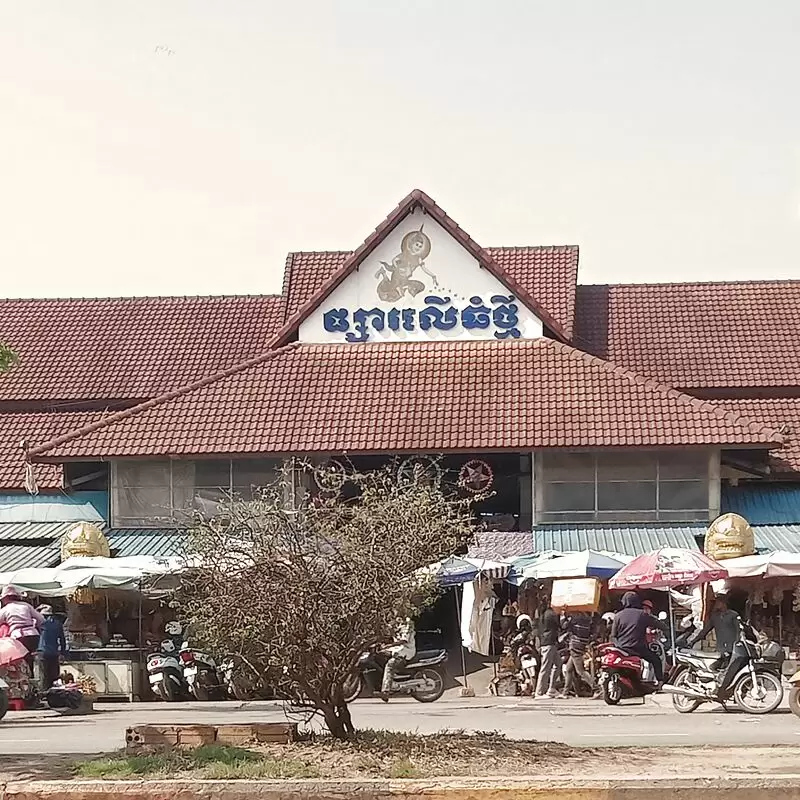 Phsar Leu Thom Tmey
Phsar Leu Thom Tmey
NR6, Krong Siem Reap
Monday - Sunday: 4:00 AM – 8:00 PM

NR6, Krong Siem Reap
25. Cambodia Landmine Museum
The Cambodia Landmine Museum in Siem Reap offers a sobering and eye-opening experience. It is not only an impressive educational center, but also a tribute to resilience in the face of adversity. You can see a series of defused landmines up close and hear victims' stories that paint a powerful picture of Cambodia's past. Insider tip: Goosebumps at the sight of homemade prosthetics. Just 25 minutes north, you'll find the extraordinary Banteay Srei Temple, a jewel of Khmer art.
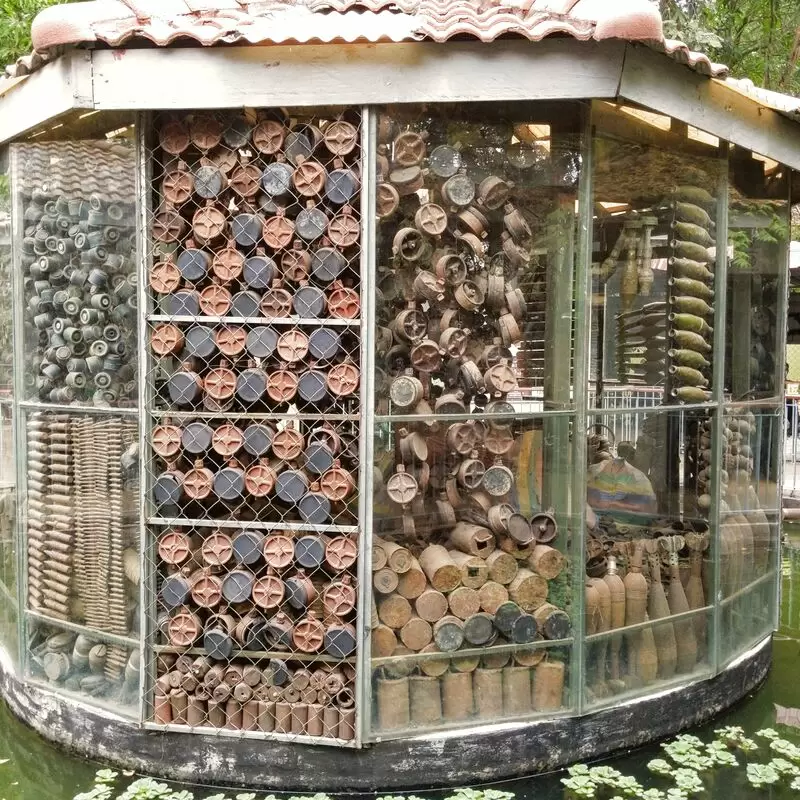 Cambodia Landmine Museum
Cambodia Landmine Museum
67, Phumi Khna
Monday - Sunday: 7:30 AM – 5:30 PM

67, Phumi Khna
26. Phnom Bok
Discover Phnom Bok, a jewel of Siem Reap, Cambodia! Phnom Bok is a less-trodden path surrounded by a rich history and home to enchanting temple ruins dating back to the time of King Yasovarman. As you climb the 635 steps, you'll be treated to a captivating panoramic view of Siem Reap. This place is also popular for the fascinating "1000 Lingas" carved into a nearby riverbed. Enjoy the tranquility away from the tourist hustle and bustle, but don't miss the magnificent sunset view! Just a stone's throw away is the enchanting Roluos group of temples, which you should definitely visit!
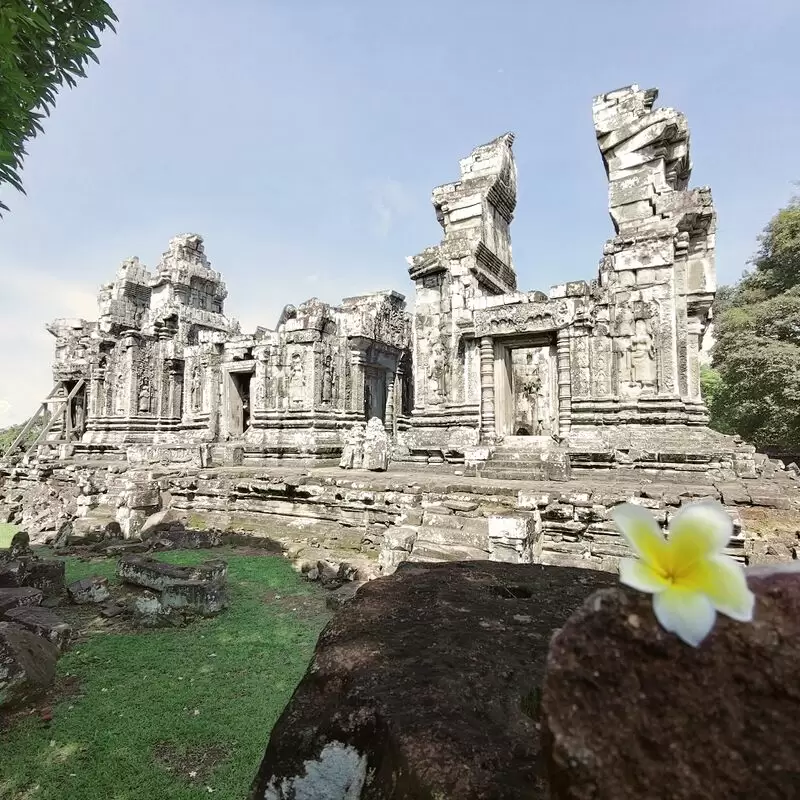 Phnom Bok
Phnom Bok
FX8M+956, Krong Siem Reap
Monday - Sunday: 7:30 AM – 5:30 PM

FX8M+956, Krong Siem Reap
Best Time to Visit Siem Reap
The best time to visit Siem Reap, Cambodia is from November to February. During these months, the weather is dry and cooler, making it perfect for sightseeing. It is also a good time to visit Angkor Wat, the city's main attraction.
Annual Weather in Siem Reap
January
Jan
71 / 92 °F
21 / 33 °C
0
1
97
February
Feb
74 / 95 °F
23 / 35 °C
0
1
91
March
Mar
78 / 101 °F
26 / 38 °C
1
3
104
April
Apr
80 / 100 °F
27 / 38 °C
2
9
66
May
May
80 / 96 °F
27 / 36 °C
2
15
52
June
Jun
78 / 93 °F
26 / 34 °C
2
16
40
July
Jul
77 / 91 °F
25 / 33 °C
3
18
28
August
Aug
77 / 91 °F
25 / 33 °C
3
20
29
September
Sep
77 / 91 °F
25 / 33 °C
5
22
26
October
Oct
76 / 90 °F
24 / 32 °C
4
16
44
November
Nov
74 / 91 °F
23 / 33 °C
1
7
65
December
Dec
71 / 91 °F
21 / 33 °C
0
2
89
Questions & Answers
What is the local language spoken in Siem Reap?
The main language spoken in Siem Reap, Cambodia is Khmer. This is the official language of Cambodia. Although Khmer uses the Latin alphabet, it has its own script with its own characters that can be challenging for non-native speakers to learn. While English and French are widely spoken among the younger generation and those working in the tourism industry, locals would appreciate a basic understanding of Khmer phrases.
Is the tap water safe to drink?
Although Cambodia has improved its water infrastructure, tap water in Siem Reap is generally considered undrinkable for visitors. The quality can vary and often contains bacteria and viruses that can cause illness. It is recommended that you drink only bottled or boiled water, use it to brush your teeth, and avoid ice in drinks. For added safety, use water purification tablets or carry a water purifier.
How prevalent is English in Siem Reap?
English is widely spoken in Siem Reap due to the influx of international tourists, especially in areas with many hotels, resorts and restaurants. Most employees in the service sector, especially tourism, can communicate well in English, and signs and menus are often written in English in addition to Khmer. Note, however, that in remote areas or among older generations, English may not be as well understood. It is still advisable to learn a few basic phrases in Khmer to enhance your travel experience.
Is Siem Reap safe for tourists?
Siem Reap, the gateway to the ruins of Angkor, is generally safe for tourists, as violent crime is rare. As with any destination, take general safety precautions. Be aware of your surroundings, especially in busy areas, as pickpocketing and bag snatching can occur. It is also important to respect the culture and customs of the locals, especially when visiting religious sites. Pay attention to local etiquette and dress codes so as not to cause offense.
What is the local cuisine in Siem Reap?
Siem Reap offers a delicious array of Cambodian cuisine that is a blend of Thai, Indian and French influences. Local cuisine consists of dishes such as Fish Amok, a coconut curry typically steamed in banana leaves, and Nom Banh Chok, a popular breakfast dish of rice noodles with fish or chicken curry. The flavor is characterized by spicy and aromatic herbal notes, especially lemongrass, paired with a generous dose of chili and garlic. Each dish creates a delicate harmony between sweet, sour, salty and spicy flavors.
What is the accessibility of ATMs?
ATMs are readily available throughout Siem Reap, Cambodia. Many international banks have branches in the city, especially in areas frequented by tourists, such as Pub Street and the Angkor Night Market. These ATMs accept major credit and debit cards and dispense money in both U.S. dollars and Cambodian riel. Due to the fees involved, it is advisable to withdraw large amounts less frequently. Remember to inform your local bank of your trip to ensure uninterrupted service.
Is vegetarian food easily available in Siem Reap?
Yes, vegetarian food is readily available in Siem Reap. The city is very accommodating to different dietary preferences. Many restaurants in Siem Reap serve a variety of vegetarian dishes inspired by local Khmer flavors, while some international eateries offer a range of Western vegetarian options. You'll also find a wide selection of fresh fruits and vegetables in the bustling local markets. So being a vegetarian in Siem Reap should not be a problem.
What is the local transport like in Siem Reap?
In Siem Reap there are various forms of traditional and modern transportation. The most popular means of transportation are tuk-tuks and bicycles, as well as motorcycles that can be rented. Tuk-tuks are a good option for getting around the narrow streets and experiencing the local lifestyle. For longer distances, cabs or private hire cars are available. Finally, there are e-bikes, an eco-friendly option favored by visitors especially for exploring temples and rural areas. Public buses are less common, but still available for travel between cities.
What is the main religion practiced in Siem Reap?
The main religion practiced in Siem Reap, as in most parts of Cambodia, is Theravada Buddhism. It plays an important role in the daily life of the Cambodian people. Numerous pagodas, statues and artwork in the city reflect strong Buddhist influences. In addition, orange-clad monks are often seen in the city's temples, illustrating the ubiquity of this spiritual faith. Other religions such as Islam, Christianity, and tribal animism are practiced by minorities.
How do locals typically dress in Siem Reap?
Cambodian people in Siem Reap typically dress conservatively and traditionally, especially in rural areas. Men generally wear plain, loose-fitting shirts that are paired with long pants. Women usually wear plain blouses and sarongs, a type of long skirt called a "sampot." However, in urban areas, Western-style clothing such as jeans and T-shirts are becoming more popular among the younger generation. Modesty is highly valued, so people are expected to cover their knees and shoulders.
Are there any local customs I should be aware of?
In Siem Reap, modest clothing is important, especially when visiting temples. Always wear clothes that cover your shoulders and knees. It is also customary to remove shoes when entering homes or certain religious sites. As in many Asian cultures, locals in Siem Reap use the two-hand or right-hand method when giving or receiving anything. Avoid touching people's heads as this is considered sacred. Also remember that public displays of affection are not as openly accepted as in Western cultures.
Is Wi-Fi commonly available in Siem Reap?
Yes, Wi-Fi is quite common in Siem Reap, Cambodia. Most hotels, guesthouses, and many cafes offer free Wi-Fi to their guests. In addition, larger establishments and tourist attractions often offer Wi-Fi, although speed and reliability may vary. It is advisable to carry a local SIM card as a backup for Internet access. Although Siem Reap is a historic and cultural city, it is well connected to the Internet.
What is the average cost of a meal in Siem Reap?
The average cost of a meal in Siem Reap is very affordable, making the city a budget-friendly destination for many travelers. For a meal at a cheap street food restaurant, you can spend between 2 and 5 USD. If you prefer to dine at a mid-range restaurant serving traditional Cambodian cuisine, expect to pay around 12 to 15 USD per person. However, prices can vary, especially for upscale restaurants. Please note that these are rough estimates and actual prices may fluctuate.
Are credit cards widely accepted in Siem Reap?
In Siem Reap, major credit cards, especially Visa and MasterCard, are accepted in many businesses, including hotels, restaurants and larger stores. However, smaller stores, local markets and rural areas mainly accept cash. The local currency is the Cambodian riel, but US dollars are also widely used. Therefore, it is advisable to always carry small bills for small transactions and tips or in cases where the use of credit cards is not possible.
What is the practice for tipping in Siem Reap?
Tipping is not obligatory in Siem Reap, but it is very much appreciated. Although a service charge is levied in many places, a small tip is often expected, especially in restaurants, bars and for personal services such as massages or guided tours. A tip of 10% of the total bill is considered generous. It is also a nice gesture to give a few dollars to your tour guide, hotel staff or tuk-tuk driver.
Are there any specific vaccinations required for Siem Reap?
While there are no required vaccinations for travel to Siem Reap, Cambodia, it is recommended to brush up on routine immunizations such as measles-mumps-rubella (MMR), diphtheria-tetanus-pertussis, chickenpox, polio and influenza. Vaccinations against hepatitis A and typhoid fever, which can be transmitted through food or water, are also recommended. Travelers should always consult with their physician before traveling.
What is the voltage and the type of plug used in Siem Reap?
In Siem Reap, Cambodia, the standard voltage is 230 V with a frequency of 50 Hz. Both Type A and Type C plugs are used in the city. Type A is a two-pin plug commonly used in the U.S. and Canada, while Type C is a two-pin plug commonly used in Europe, South America and Asia. It is always a good idea to travel with a universal adapter to use different types of outlets.
What is the currency used in Siem Reap?
The official currency of Siem Reap, Cambodia, is the Cambodian Riel (KHR). However, the U.S. dollar is accepted everywhere in the city and is often preferred. Many businesses, including hotels, restaurants, and markets, quote their prices in U.S. dollars, and even small merchants accept them. It is also not uncommon to receive change in a mixture of riel and U.S. dollars. Credit cards are generally accepted in hotels and upscale restaurants, but cash is still the primary form of payment, especially for small amounts.
How is the healthcare in Siem Reap?
Siem Reap is one of the most developed provinces in Cambodia and offers remarkable health care. Local hospitals and clinics provide basic medical services, but with limited resources. For comprehensive care and specialized treatments, private hospitals and international clinics catering to tourists and expatriates are more reliable. Be sure to purchase travel insurance, as medical care can be expensive. Pharmacies are plentiful, but always make sure to visit reputable pharmacies, as counterfeit drugs are common. Medical evacuation to Bangkok may be advised for serious illnesses.
Is public transportation safe to use in Siem Reap?
Yes, public transportation in Siem Reap is safe, reliable and generally efficient. Options include tuk-tuks, cabs and bicycles, which are perfect for short distances within the city. For longer distances, there are well-maintained buses and organized tourist shuttles. However, it is advisable to negotiate the fare in advance and make sure the drivers know your destination.
What is the emergency number in Siem Reap?
If you need emergency services in Siem Reap, Cambodia, you can dial 119 from any local phone. This will connect you with the local police. For medical emergencies, it is best to contact nearby hospitals and clinics directly, as there is no single, central number for medical emergencies. Please note that English language skills may not be very good. Therefore, ask a local English-speaking person for assistance if needed. Always have your location information ready.
Are there any local festivals that I should know about?
Yes, the Cambodian New Year or "Khmer New Year" is an important event in Siem Reap, where locals hold religious activities, traditional games and lively parades. Another notable festival is the "Bon Om Touk" water festival, which celebrates the change in flow of the Tonle Sap River. It features boat races, illuminated rafts, fireworks and music. Finally, at Pchum Ben, a 15-day religious festival, Cambodians pay their last respects to their deceased relatives through rituals and offerings in Buddhist temples.
Is it safe to walk around at night in Siem Reap?
Siem Reap is generally considered safe for tourists, even at night. Most residents are friendly and respectful of foreigners and crime is relatively low. The city is populated with busy markets, restaurants and bars that are quite safe. However, like anywhere else in the world, you should take general precautions, avoid unnecessary risks, and always stay in well-traveled and well-lit areas. Always be aware of your surroundings and keep your personal belongings safe.
Is bargaining a common practice at local markets?
Yes, haggling is indeed a common practice in the local markets in Siem Reap, Cambodia. Vendors expect a bit of haggling, and many start with a much higher price, knowing that there will be bargaining afterward. This is part of the Cambodian shopping culture that locals and tourists actively participate in. Just remember to remain friendly during the exchange, as it is more of a social interaction than a simple transaction.
What are the rules and customs regarding visiting Buddhist temples?
When visiting Buddhist temples in Siem Reap, respect is paramount. Dress modestly, cover your shoulders and knees, and remove your shoes before entering the temple. Speak softly and avoid pointing your feet toward the Buddha statues. Always ask permission before taking photos and do not touch, sit near or climb on the statues. It is customary to donate a small amount of money after the prayer. Do not disturb the monks or the locals during their prayers. Show respect by bowing slightly when you see Buddha statues.
Feedback
I hope you found this article informative and helpful. I'm eager to improve the content and make it even more valuable for you. If you have any feedback or suggestions, I would love to hear from you.
Do you have any tips or hidden gems that you think should be added to the list? Are there any areas that you feel could use more explanation or clarification?
Your input is greatly appreciated and will help us to continue providing high-quality content that meets your needs and interests. Please feel free to share your thoughts.
What is the local language spoken in Siem Reap?
The main language spoken in Siem Reap, Cambodia is Khmer. This is the official language of Cambodia. Although Khmer uses the Latin alphabet, it has its own script with its own characters that can be challenging for non-native speakers to learn. While English and French are widely spoken among the younger generation and those working in the tourism industry, locals would appreciate a basic understanding of Khmer phrases.
Is the tap water safe to drink?
Although Cambodia has improved its water infrastructure, tap water in Siem Reap is generally considered undrinkable for visitors. The quality can vary and often contains bacteria and viruses that can cause illness. It is recommended that you drink only bottled or boiled water, use it to brush your teeth, and avoid ice in drinks. For added safety, use water purification tablets or carry a water purifier.
How prevalent is English in Siem Reap?
English is widely spoken in Siem Reap due to the influx of international tourists, especially in areas with many hotels, resorts and restaurants. Most employees in the service sector, especially tourism, can communicate well in English, and signs and menus are often written in English in addition to Khmer. Note, however, that in remote areas or among older generations, English may not be as well understood. It is still advisable to learn a few basic phrases in Khmer to enhance your travel experience.
Is Siem Reap safe for tourists?
Siem Reap, the gateway to the ruins of Angkor, is generally safe for tourists, as violent crime is rare. As with any destination, take general safety precautions. Be aware of your surroundings, especially in busy areas, as pickpocketing and bag snatching can occur. It is also important to respect the culture and customs of the locals, especially when visiting religious sites. Pay attention to local etiquette and dress codes so as not to cause offense.
What is the local cuisine in Siem Reap?
Siem Reap offers a delicious array of Cambodian cuisine that is a blend of Thai, Indian and French influences. Local cuisine consists of dishes such as Fish Amok, a coconut curry typically steamed in banana leaves, and Nom Banh Chok, a popular breakfast dish of rice noodles with fish or chicken curry. The flavor is characterized by spicy and aromatic herbal notes, especially lemongrass, paired with a generous dose of chili and garlic. Each dish creates a delicate harmony between sweet, sour, salty and spicy flavors.
What is the accessibility of ATMs?
ATMs are readily available throughout Siem Reap, Cambodia. Many international banks have branches in the city, especially in areas frequented by tourists, such as Pub Street and the Angkor Night Market. These ATMs accept major credit and debit cards and dispense money in both U.S. dollars and Cambodian riel. Due to the fees involved, it is advisable to withdraw large amounts less frequently. Remember to inform your local bank of your trip to ensure uninterrupted service.
Is vegetarian food easily available in Siem Reap?
Yes, vegetarian food is readily available in Siem Reap. The city is very accommodating to different dietary preferences. Many restaurants in Siem Reap serve a variety of vegetarian dishes inspired by local Khmer flavors, while some international eateries offer a range of Western vegetarian options. You'll also find a wide selection of fresh fruits and vegetables in the bustling local markets. So being a vegetarian in Siem Reap should not be a problem.
What is the local transport like in Siem Reap?
In Siem Reap there are various forms of traditional and modern transportation. The most popular means of transportation are tuk-tuks and bicycles, as well as motorcycles that can be rented. Tuk-tuks are a good option for getting around the narrow streets and experiencing the local lifestyle. For longer distances, cabs or private hire cars are available. Finally, there are e-bikes, an eco-friendly option favored by visitors especially for exploring temples and rural areas. Public buses are less common, but still available for travel between cities.
What is the main religion practiced in Siem Reap?
The main religion practiced in Siem Reap, as in most parts of Cambodia, is Theravada Buddhism. It plays an important role in the daily life of the Cambodian people. Numerous pagodas, statues and artwork in the city reflect strong Buddhist influences. In addition, orange-clad monks are often seen in the city's temples, illustrating the ubiquity of this spiritual faith. Other religions such as Islam, Christianity, and tribal animism are practiced by minorities.
How do locals typically dress in Siem Reap?
Cambodian people in Siem Reap typically dress conservatively and traditionally, especially in rural areas. Men generally wear plain, loose-fitting shirts that are paired with long pants. Women usually wear plain blouses and sarongs, a type of long skirt called a "sampot." However, in urban areas, Western-style clothing such as jeans and T-shirts are becoming more popular among the younger generation. Modesty is highly valued, so people are expected to cover their knees and shoulders.
Are there any local customs I should be aware of?
In Siem Reap, modest clothing is important, especially when visiting temples. Always wear clothes that cover your shoulders and knees. It is also customary to remove shoes when entering homes or certain religious sites. As in many Asian cultures, locals in Siem Reap use the two-hand or right-hand method when giving or receiving anything. Avoid touching people's heads as this is considered sacred. Also remember that public displays of affection are not as openly accepted as in Western cultures.
Is Wi-Fi commonly available in Siem Reap?
Yes, Wi-Fi is quite common in Siem Reap, Cambodia. Most hotels, guesthouses, and many cafes offer free Wi-Fi to their guests. In addition, larger establishments and tourist attractions often offer Wi-Fi, although speed and reliability may vary. It is advisable to carry a local SIM card as a backup for Internet access. Although Siem Reap is a historic and cultural city, it is well connected to the Internet.
What is the average cost of a meal in Siem Reap?
The average cost of a meal in Siem Reap is very affordable, making the city a budget-friendly destination for many travelers. For a meal at a cheap street food restaurant, you can spend between 2 and 5 USD. If you prefer to dine at a mid-range restaurant serving traditional Cambodian cuisine, expect to pay around 12 to 15 USD per person. However, prices can vary, especially for upscale restaurants. Please note that these are rough estimates and actual prices may fluctuate.
Are credit cards widely accepted in Siem Reap?
In Siem Reap, major credit cards, especially Visa and MasterCard, are accepted in many businesses, including hotels, restaurants and larger stores. However, smaller stores, local markets and rural areas mainly accept cash. The local currency is the Cambodian riel, but US dollars are also widely used. Therefore, it is advisable to always carry small bills for small transactions and tips or in cases where the use of credit cards is not possible.
What is the practice for tipping in Siem Reap?
Tipping is not obligatory in Siem Reap, but it is very much appreciated. Although a service charge is levied in many places, a small tip is often expected, especially in restaurants, bars and for personal services such as massages or guided tours. A tip of 10% of the total bill is considered generous. It is also a nice gesture to give a few dollars to your tour guide, hotel staff or tuk-tuk driver.
Are there any specific vaccinations required for Siem Reap?
While there are no required vaccinations for travel to Siem Reap, Cambodia, it is recommended to brush up on routine immunizations such as measles-mumps-rubella (MMR), diphtheria-tetanus-pertussis, chickenpox, polio and influenza. Vaccinations against hepatitis A and typhoid fever, which can be transmitted through food or water, are also recommended. Travelers should always consult with their physician before traveling.
What is the voltage and the type of plug used in Siem Reap?
In Siem Reap, Cambodia, the standard voltage is 230 V with a frequency of 50 Hz. Both Type A and Type C plugs are used in the city. Type A is a two-pin plug commonly used in the U.S. and Canada, while Type C is a two-pin plug commonly used in Europe, South America and Asia. It is always a good idea to travel with a universal adapter to use different types of outlets.
What is the currency used in Siem Reap?
The official currency of Siem Reap, Cambodia, is the Cambodian Riel (KHR). However, the U.S. dollar is accepted everywhere in the city and is often preferred. Many businesses, including hotels, restaurants, and markets, quote their prices in U.S. dollars, and even small merchants accept them. It is also not uncommon to receive change in a mixture of riel and U.S. dollars. Credit cards are generally accepted in hotels and upscale restaurants, but cash is still the primary form of payment, especially for small amounts.
How is the healthcare in Siem Reap?
Siem Reap is one of the most developed provinces in Cambodia and offers remarkable health care. Local hospitals and clinics provide basic medical services, but with limited resources. For comprehensive care and specialized treatments, private hospitals and international clinics catering to tourists and expatriates are more reliable. Be sure to purchase travel insurance, as medical care can be expensive. Pharmacies are plentiful, but always make sure to visit reputable pharmacies, as counterfeit drugs are common. Medical evacuation to Bangkok may be advised for serious illnesses.
Is public transportation safe to use in Siem Reap?
Yes, public transportation in Siem Reap is safe, reliable and generally efficient. Options include tuk-tuks, cabs and bicycles, which are perfect for short distances within the city. For longer distances, there are well-maintained buses and organized tourist shuttles. However, it is advisable to negotiate the fare in advance and make sure the drivers know your destination.
What is the emergency number in Siem Reap?
If you need emergency services in Siem Reap, Cambodia, you can dial 119 from any local phone. This will connect you with the local police. For medical emergencies, it is best to contact nearby hospitals and clinics directly, as there is no single, central number for medical emergencies. Please note that English language skills may not be very good. Therefore, ask a local English-speaking person for assistance if needed. Always have your location information ready.
Are there any local festivals that I should know about?
Yes, the Cambodian New Year or "Khmer New Year" is an important event in Siem Reap, where locals hold religious activities, traditional games and lively parades. Another notable festival is the "Bon Om Touk" water festival, which celebrates the change in flow of the Tonle Sap River. It features boat races, illuminated rafts, fireworks and music. Finally, at Pchum Ben, a 15-day religious festival, Cambodians pay their last respects to their deceased relatives through rituals and offerings in Buddhist temples.
Is it safe to walk around at night in Siem Reap?
Siem Reap is generally considered safe for tourists, even at night. Most residents are friendly and respectful of foreigners and crime is relatively low. The city is populated with busy markets, restaurants and bars that are quite safe. However, like anywhere else in the world, you should take general precautions, avoid unnecessary risks, and always stay in well-traveled and well-lit areas. Always be aware of your surroundings and keep your personal belongings safe.
Is bargaining a common practice at local markets?
Yes, haggling is indeed a common practice in the local markets in Siem Reap, Cambodia. Vendors expect a bit of haggling, and many start with a much higher price, knowing that there will be bargaining afterward. This is part of the Cambodian shopping culture that locals and tourists actively participate in. Just remember to remain friendly during the exchange, as it is more of a social interaction than a simple transaction.
What are the rules and customs regarding visiting Buddhist temples?
When visiting Buddhist temples in Siem Reap, respect is paramount. Dress modestly, cover your shoulders and knees, and remove your shoes before entering the temple. Speak softly and avoid pointing your feet toward the Buddha statues. Always ask permission before taking photos and do not touch, sit near or climb on the statues. It is customary to donate a small amount of money after the prayer. Do not disturb the monks or the locals during their prayers. Show respect by bowing slightly when you see Buddha statues.
Feedback
I hope you found this article informative and helpful. I'm eager to improve the content and make it even more valuable for you. If you have any feedback or suggestions, I would love to hear from you.
Do you have any tips or hidden gems that you think should be added to the list? Are there any areas that you feel could use more explanation or clarification?
Your input is greatly appreciated and will help us to continue providing high-quality content that meets your needs and interests. Please feel free to share your thoughts.
I hope you found this article informative and helpful. I'm eager to improve the content and make it even more valuable for you. If you have any feedback or suggestions, I would love to hear from you.
Do you have any tips or hidden gems that you think should be added to the list? Are there any areas that you feel could use more explanation or clarification?
Your input is greatly appreciated and will help us to continue providing high-quality content that meets your needs and interests. Please feel free to share your thoughts.

